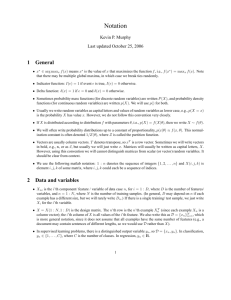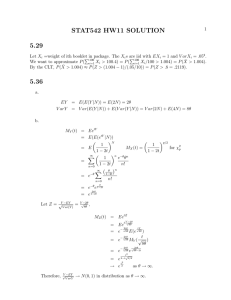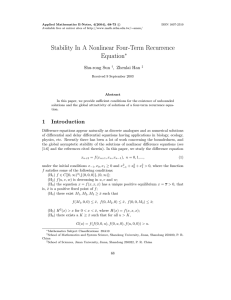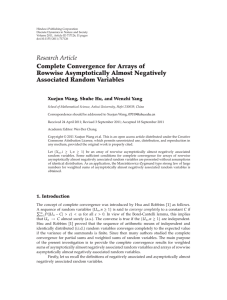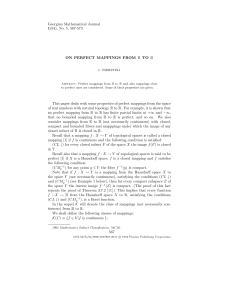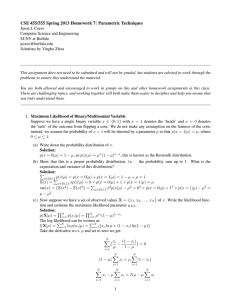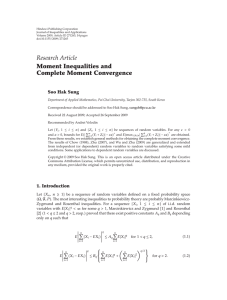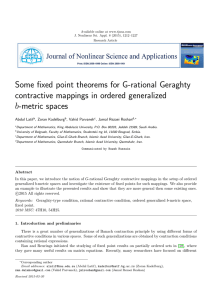Document 10851707
advertisement
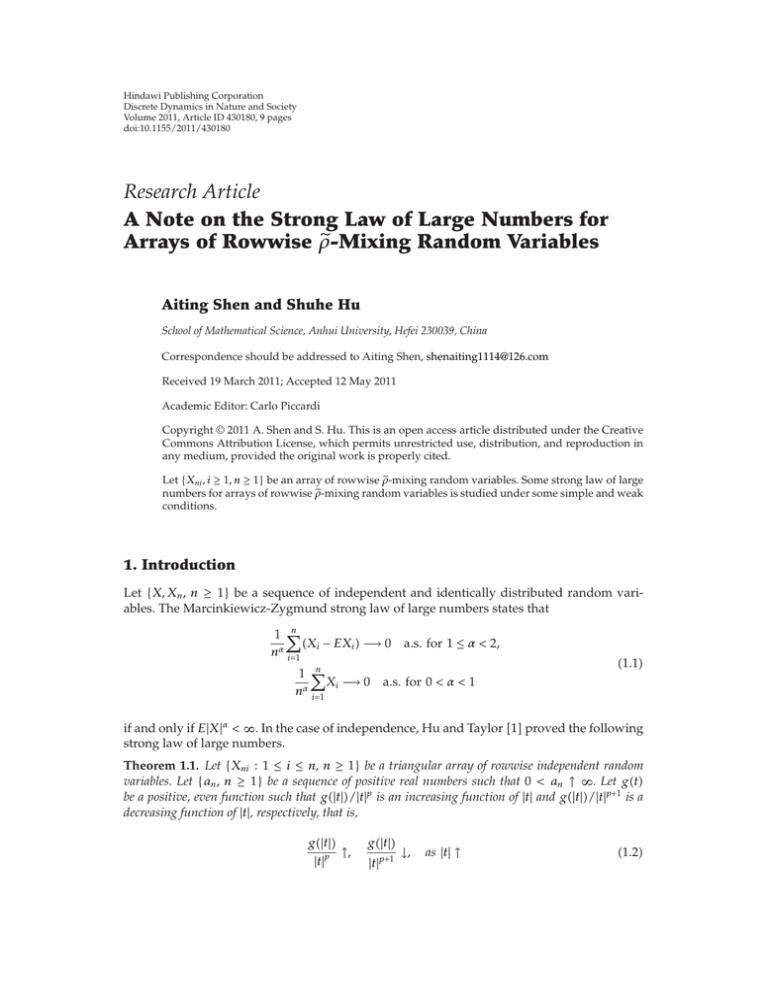
Hindawi Publishing Corporation
Discrete Dynamics in Nature and Society
Volume 2011, Article ID 430180, 9 pages
doi:10.1155/2011/430180
Research Article
A Note on the Strong Law of Large Numbers for
Arrays of Rowwise ρ-Mixing
Random Variables
Aiting Shen and Shuhe Hu
School of Mathematical Science, Anhui University, Hefei 230039, China
Correspondence should be addressed to Aiting Shen, shenaiting1114@126.com
Received 19 March 2011; Accepted 12 May 2011
Academic Editor: Carlo Piccardi
Copyright q 2011 A. Shen and S. Hu. This is an open access article distributed under the Creative
Commons Attribution License, which permits unrestricted use, distribution, and reproduction in
any medium, provided the original work is properly cited.
random variables. Some strong law of large
Let {Xni , i ≥ 1, n ≥ 1} be an array of rowwise ρ-mixing
numbers for arrays of rowwise ρ-mixing
random variables is studied under some simple and weak
conditions.
1. Introduction
Let {X, Xn , n ≥ 1} be a sequence of independent and identically distributed random variables. The Marcinkiewicz-Zygmund strong law of large numbers states that
n
1
Xi − EXi −→ 0
α
n i1
a.s. for 1 ≤ α < 2,
n
1
Xi −→ 0 a.s. for 0 < α < 1
α
n i1
1.1
if and only if E|X|α < ∞. In the case of independence, Hu and Taylor 1 proved the following
strong law of large numbers.
Theorem 1.1. Let {Xni : 1 ≤ i ≤ n, n ≥ 1} be a triangular array of rowwise independent random
variables. Let {an , n ≥ 1} be a sequence of positive real numbers such that 0 < an ↑ ∞. Let gt
be a positive, even function such that g|t|/|t|p is an increasing function of |t| and g|t|/|t|p1 is a
decreasing function of |t|, respectively, that is,
g|t|
↑,
|t|p
g|t|
|t|p1
↓,
as |t| ↑
1.2
2
Discrete Dynamics in Nature and Society
for some nonnegative integer p. If p ≥ 2 and
EXni 0,
n
∞ g|Xni |
< ∞,
E
gan n1 i1
1.3
2k
∞
n
Xni 2
E
< ∞,
an
n1
i1
where k is a positive integer, then
n
1
Xni −→ 0
an i1
a.s. as n −→ ∞.
1.4
Zhu 2 generalized and improved the result of Hu and Taylor 1 for triangular arrays
of rowwise independent random variables to the case of arrays of rowwise ρ-mixing
random
variables as follows.
Theorem 1.2. Let {Xni : i ≥ 1, n ≥ 1} be an array of rowwise ρ-mixing
random variables. Let
{an , n ≥ 1} be a sequence of positive real numbers such that 0 < an ↑ ∞. Let gt be a positive, even
function such that g|t|/|t| is an increasing function of |t| and g|t|/|t|p is a decreasing function of
|t|, respectively, that is,
g|t|
↑,
|t|
g|t|
↓,
|t|p
as |t| ↑
1.5
for some nonnegative integer p. If p ≥ 2 and
EXni 0,
n
∞ g|Xni |
< ∞,
E
gan n1 i1
1.6
v/2
∞
n
Xni 2
E
< ∞,
an
n1
i1
where v is a positive integer, v ≥ p, then
∀ε > 0,
∞
n1
j
1
max
Xni > ε < ∞.
1≤j≤n an
i1
P
1.7
In the following, we will give the definitions of a ρ-mixing
sequence and the array of
rowwise ρ-mixing
random variables.
Discrete Dynamics in Nature and Society
3
Let {Xn , n ≥ 1} be a sequence of random variables defined on a fixed probability space
Ω, F, P . Write FS σXi , i ∈ S ⊂ N. For any given σ-algebras B, R in F, let
ρB, R sup
|EXY − EXEY |
X∈L2 B,Y ∈L2 R Var X Var Y 1/2
.
1.8
Define the ρ-mixing
coefficients by
ρk
sup ρFS , FT : S, T are finite subsets of N such that distS, T ≥ k ,
k ≥ 0.
1.9
Obviously, 0 ≤ ρk
1 ≤ ρk
≤ 1 and ρ0
1.
sequence
Definition 1.3. A sequence {Xn , n ≥ 1} of random variables is said to be a ρ-mixing
if, there exists k ∈ N such that ρk
< 1.
if for every
An array of random variables {Xni , i ≥ 1, n ≥ 1} is called rowwise ρ-mixing
sequence of random variables.
n ≥ 1, {Xni , i ≥ 1} is a ρ-mixing
The ρ-mixing
random variables were introduced by Bradley 3, and many applications have been found. ρ-mixing
is similar to ρ-mixing, but both are quite different. Many
authors have studied this concept providing interesting results and applications. See, for
example, Zhu 2, An and Yuan 4, Kuczmaszewska 5, Bryc and Smoleński 6, Cai 7, Gan
8, Peligrad 9, 10, Peligrad and Gut 11, Sung 12, Utev and Peligrad 13, Wu and Jiang
14, and so on. When these are compared with the corresponding results of independent
random variable sequences, there still remains much to be desired.
The main purpose of this paper is to further study the strong law of large numbers for
arrays of rowwise ρ-mixing
random variables. We will introduce some simple conditions to
prove the strong law of large numbers. The techniques used in the paper are inspired by Zhu
2.
2. Main Results
Throughout the paper, let IA be the indicator function of the set A. C denotes a positive
constant which may be different in various places.
The proofs of the main results of this paper are based upon the following lemma.
Lemma 2.1 Utev and Peligrad 13, Theorem 2.1. Let {Xn , n ≥ 1} be a ρ-mixing
sequence of
random variables, EXi 0, E|Xi |p < ∞ for some p ≥ 2 and for every i ≥ 1. Then, there exists a
positive constant C depending only on p such that
⎧
j
⎞
p/2 ⎫
n
n
⎨
⎬
p
E⎝max Xi ⎠ ≤ C
.
E|Xi |p EXi2
⎩ i1
⎭
1≤j≤n
i1
i1
⎛
2.1
4
Discrete Dynamics in Nature and Society
As for arrays of rowwise ρ-mixing
random variables {Xni : i ≥ 1, n ≥ 1}, we assume
that the constant C from Lemma 2.1 is the same for each row throughout the paper. Our main
results are as follows.
random variables and let
Theorem 2.2. Let {Xni : i ≥ 1, n ≥ 1} be an array of rowwise ρ-mixing
{an , n ≥ 1} be a sequence of positive real numbers. Let {gn t, n ≥ 1} be a sequence of positive, even
functions such that gn |t| is an increasing function of |t| and gn |t|/|t| is a decreasing function of |t|
for every n ≥ 1, respectively, that is,
gn |t| ↑,
gn |t|
↓,
|t|
as |t| ↑ .
2.2
If
n
∞ Egn |Xni |
n1 i1
gn an < ∞,
2.3
then, for any ε > 0,
∞
P
n1
j
1
max
Xni > ε < ∞.
1≤j≤n an
i1
2.4
Proof. For fixed n ≥ 1, define
n
Xi
n
Tj
Xni I|Xni | ≤ an ,
1 n
n
Xi − EXi ,
an i1
i ≥ 1,
j
j 1, 2, . . . , n.
2.5
It is easy to check that for any ε > 0,
j
j
1
1
n max
Xni > ε ⊂ max|Xni | > an
Xi > ε ,
max
1≤j≤n an
1≤i≤n
1≤j≤n an
i1
i1
2.6
which implies that
j
j
1
1
n max
Xni > ε ≤ P max|Xni | > an P max
Xi > ε
1≤j≤n an
1≤i≤n
1≤j≤n an
i1
i1
P
n
≤
P |Xni | > an P
i1
j
1
n n EXi .
maxTj > ε − max
1≤j≤n
1≤j≤n an
i1
2.7
Discrete Dynamics in Nature and Society
5
Firstly, we will show that
j
1
n EXi −→ 0,
max
1≤j≤n an
i1
as n −→ ∞.
2.8
Actually, by conditions gn |t|/|t| ↓ as |t| ↑ and 2.3, we have that
j
j
1
1
n max
EXi max
EXni I|Xni | ≤ an 1≤j≤n an
1≤j≤n an
i1
i1
n
1
E|Xni |I|Xni | ≤ an an i1
≤
≤
n
Egn |Xni |I|Xni | ≤ an gn an i1
≤
n
Egn |Xni |
i1
2.9
gn an −→ 0,
as n −→ ∞,
which implies 2.8. It follows from 2.7 and 2.8 that for n large enough,
P
j
n
1
n ε
.
Xni > ε ≤
P |Xni | > an P maxTj >
max
1≤j≤n an
1≤j≤n
2
i1
i1
2.10
Hence, to prove 2.4, we only need to show that
n
∞ P |Xni | > an < ∞,
2.11
n1 i1
∞ n ε
P maxTj >
< ∞.
1≤j≤n
2
n1
2.12
The conditions gn |t| ↑ as |t| ↑ and 2.3 yield that
∞ n
n1 i1
which implies 2.11.
P |Xni | > an ≤
∞ n
Egn |Xni |
n1 i1
gn an < ∞,
2.13
6
Discrete Dynamics in Nature and Society
By Markov’s inequality, Lemma 2.1 for p 2, Cr ’s inequality, gn |t|/|t| ↓ as |t| ↑ and
2.3, we can get that
∞ ∞ n ε
n 2
P maxTj >
≤ C E maxTj 1≤j≤n
1≤j≤n
2
n1
n1
≤C
∞
n
1
n
n 2
E
−
EX
X
i
i
2
n1 an i1
≤C
∞
n
1
n 2
E
X
i
2
n1 an i1
C
∞ n
E|Xni |2 I|Xni | ≤ an a2n
n1 i1
≤C
n
∞ E|Xni |I|Xni | ≤ an an
n1 i1
≤C
∞ n
Egn |Xni |I|Xni | ≤ an gn an n1 i1
≤C
2.14
n
∞ Egn |Xni |
n1 i1
gn an < ∞,
which implies 2.12. This completes the proof of the theorem.
Corollary 2.3. Under the conditions of Theorem 2.2,
n
1
Xni −→ 0
an i1
a.s. as n −→ ∞.
2.15
Theorem 2.4. Let {Xni : i ≥ 1, n ≥ 1} be an array of rowwise ρ-mixing
random variables and let
{an , n ≥ 1} be a sequence of positive real numbers. Let {gn t, n ≥ 1} be a sequence of nonnegative,
even functions such that gn |t| is an increasing function of |t| for every n ≥ 1. Assume that there
exists a constant δ > 0 such that gn t ≥ δt for 0 < t ≤ 1. If
∞ n
Xni
Egn
< ∞,
an
n1 i1
2.16
then for any ε > 0, 2.4 holds true.
Proof. We use the same notations as that in Theorem 2.2. The proof is similar to that of
Theorem 2.2.
Discrete Dynamics in Nature and Society
7
Firstly, we will show that 2.8 holds true. In fact, by the conditions gn t ≥ δt for
0 < t ≤ 1 and 2.16, we have that
j
j
1
1
n EXi max
EXni I|Xni | ≤ an max
1≤j≤n an
1≤j≤n an
i1
i1
≤
n
|Xni |
E
I|Xni | ≤ an an
i1
n
1
Xni
≤
Egn
I|Xni | ≤ an δ i1
an
n
1
Xni
≤
Egn
−→ 0,
δ i1
an
2.17
as n −→ ∞,
which implies 2.8.
According to the proof of Theorem 2.2, we only need to prove that 2.11 and 2.12
hold true.
When |Xni | > an > 0, we have gn Xni /an ≥ gn 1 ≥ δ, which yields that
Xni
1
Egn
.
δ
an
2.18
n
n
∞ ∞ Xni
1
P |Xni | > an ≤
Egn
< ∞,
δ n1 i1
an
n1 i1
2.19
P |Xni | > an EI|Xni | > an ≤
Hence,
which implies 2.11.
By Markov’s inequality, Lemma 2.1 for p 2, Cr ’s inequality, gn t ≥ δt for 0 < t ≤ 1
and 2.16, we can get that
n
∞ ∞ E|Xni |2 I|Xni | ≤ an n ε
≤C
P maxTj >
1≤j≤n
2
a2n
n1
n1 i1
≤C
n
∞ E|Xni |I|Xni | ≤ an n1 i1
an
∞ n
Xni
≤C
Egn
I|Xni | ≤ an an
n1 i1
≤C
n
∞ Xni
Egn
< ∞,
an
n1 i1
which implies 2.12. This completes the proof of the theorem.
2.20
8
Discrete Dynamics in Nature and Society
Corollary 2.5. Under the conditions of Theorem 2.4,
n
1
Xni −→ 0
an i1
a.s. as n −→ ∞.
2.21
random variables and let
Corollary 2.6. Let {Xni , i ≥ 1, n ≥ 1} be an array of rowwise ρ-mixing
{an , n ≥ 1} be a positive real numbers. If there exists a constant β ∈ 0, 1 such that
∞ n
n1 i1
E
|Xni |β
|an |β |Xni |β
< ∞,
2.22
then 2.4 holds true.
Proof. In Theorem 2.4, we take
gn t |t|β
1 |t|β
,
0 < β ≤ 1, n ≥ 1.
2.23
It is easy to check that {gn t, n ≥ 1} is a sequence of nonnegative, even functions such that
gn |t| is an increasing function of |t| for every n ≥ 1. And
gn t ≥
1 β 1
t ≥ t,
2
2
0 < t ≤ 1, 0 < β ≤ 1.
2.24
Therefore, by Theorem 2.4, we can easily get 2.4.
Acknowledgments
The authors are most grateful to the editor Carlo Piccardi and anonymous referee for careful
reading of the paper and valuable suggestions which helped to improve an earlier version
of this paper. This work is supported by the National Natural Science Foundation of China
10871001 and the Academic innovation team of Anhui University KJTD001B.
References
1 T.-C. Hu and R. L. Taylor, “On the strong law for arrays and for the bootstrap mean and variance,”
International Journal of Mathematics and Mathematical Sciences, vol. 20, no. 2, pp. 375–382, 1997.
2 M.-H. Zhu, “Strong laws of large numbers for arrays of rowwise ρ-mixing
random variables,” Discrete
Dynamics in Nature and Society, vol. 2007, Article ID 74296, 6 pages, 2007.
3 R. C. Bradley, “On the spectral density and asymptotic normality of weakly dependent random
fields,” Journal of Theoretical Probability, vol. 5, no. 2, pp. 355–373, 1992.
4 J. An and D. M. Yuan, “Complete convergence of weighted sums for ρ-mixing
sequence of random
variables,” Statistics & Probability Letters, vol. 78, no. 12, pp. 1466–1472, 2008.
5 A. Kuczmaszewska, “On Chung-Teicher type strong law of large numbers for ρ-mixing
random
variables,” Discrete Dynamics in Nature and Society, vol. 2008, Article ID 140548, 10 pages, 2008.
6 W. Bryc and W. Smoleński, “Moment conditions for almost sure convergence of weakly correlated
random variables,” Proceedings of the American Mathematical Society, vol. 119, no. 2, pp. 629–635, 1993.
Discrete Dynamics in Nature and Society
9
7 G.-H. Cai, “Strong law of large numbers for ρ-mixing
sequences with different distributions,” Discrete
Dynamics in Nature and Society, vol. 2006, Article ID 27648, 7 pages, 2006.
8 S. X. Gan, “Almost sure convergence for ρ-mixing
random variable sequences,” Statistics & Probability
Letters, vol. 67, no. 4, pp. 289–298, 2004.
9 M. Peligrad, “On the asymptotic normality of sequences of weak dependent random variables,”
Journal of Theoretical Probability, vol. 9, no. 3, pp. 703–715, 1996.
10 M. Peligrad, “Maximum of partial sums and an invariance principle for a class of weak dependent
random variables,” Proceedings of the American Mathematical Society, vol. 126, no. 4, pp. 1181–1189,
1998.
11 M. Peligrad and A. Gut, “Almost-sure results for a class of dependent random variables,” Journal of
Theoretical Probability, vol. 12, no. 1, pp. 87–104, 1999.
12 S. H. Sung, “Complete convergence for weighted sums of ρ-mixing
random variables,” Discrete
Dynamics in Nature and Society, vol. 2010, Article ID 630608, 13 pages, 2010.
13 S. Utev and M. Peligrad, “Maximal inequalities and an invariance principle for a class of weakly
dependent random variables,” Journal of Theoretical Probability, vol. 16, no. 1, pp. 101–115, 2003.
14 Q. Wu and Y. Jiang, “Some strong limit theorems for ρ-mixing
sequences of random variables,”
Statistics & Probability Letters, vol. 78, no. 8, pp. 1017–1023, 2008.
Advances in
Operations Research
Hindawi Publishing Corporation
http://www.hindawi.com
Volume 2014
Advances in
Decision Sciences
Hindawi Publishing Corporation
http://www.hindawi.com
Volume 2014
Mathematical Problems
in Engineering
Hindawi Publishing Corporation
http://www.hindawi.com
Volume 2014
Journal of
Algebra
Hindawi Publishing Corporation
http://www.hindawi.com
Probability and Statistics
Volume 2014
The Scientific
World Journal
Hindawi Publishing Corporation
http://www.hindawi.com
Hindawi Publishing Corporation
http://www.hindawi.com
Volume 2014
International Journal of
Differential Equations
Hindawi Publishing Corporation
http://www.hindawi.com
Volume 2014
Volume 2014
Submit your manuscripts at
http://www.hindawi.com
International Journal of
Advances in
Combinatorics
Hindawi Publishing Corporation
http://www.hindawi.com
Mathematical Physics
Hindawi Publishing Corporation
http://www.hindawi.com
Volume 2014
Journal of
Complex Analysis
Hindawi Publishing Corporation
http://www.hindawi.com
Volume 2014
International
Journal of
Mathematics and
Mathematical
Sciences
Journal of
Hindawi Publishing Corporation
http://www.hindawi.com
Stochastic Analysis
Abstract and
Applied Analysis
Hindawi Publishing Corporation
http://www.hindawi.com
Hindawi Publishing Corporation
http://www.hindawi.com
International Journal of
Mathematics
Volume 2014
Volume 2014
Discrete Dynamics in
Nature and Society
Volume 2014
Volume 2014
Journal of
Journal of
Discrete Mathematics
Journal of
Volume 2014
Hindawi Publishing Corporation
http://www.hindawi.com
Applied Mathematics
Journal of
Function Spaces
Hindawi Publishing Corporation
http://www.hindawi.com
Volume 2014
Hindawi Publishing Corporation
http://www.hindawi.com
Volume 2014
Hindawi Publishing Corporation
http://www.hindawi.com
Volume 2014
Optimization
Hindawi Publishing Corporation
http://www.hindawi.com
Volume 2014
Hindawi Publishing Corporation
http://www.hindawi.com
Volume 2014
